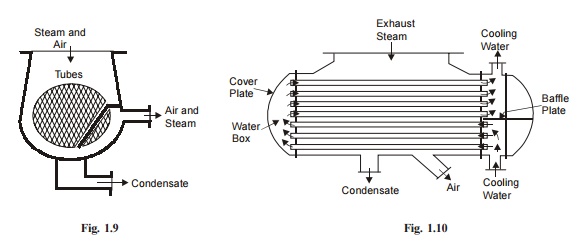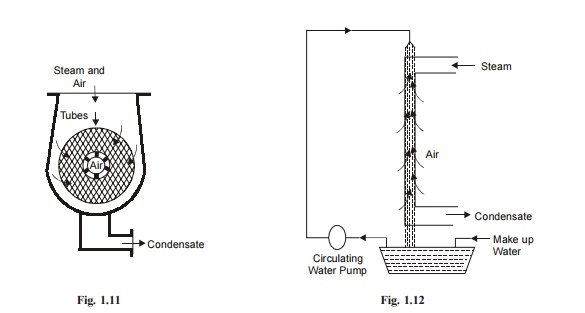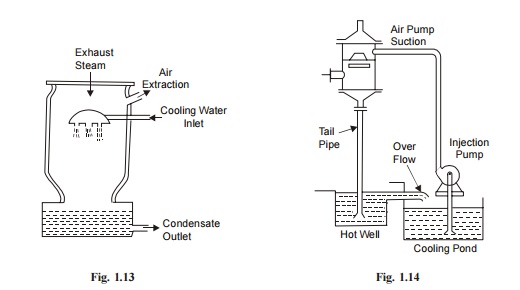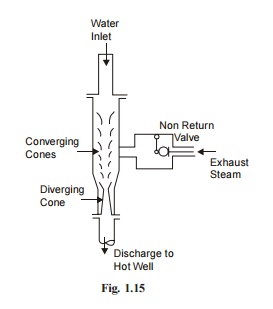Chapter: Power Plant Engineering Fundamental
Steam Condensers and Types of Steam Condensers

STEAM
CONDENSERS
Thermal efficiency of a closed cycle power developing system
using steam as working fluid and working on Carnot cycle is given by an
expression (T1 - T2)/T1. This expression of
efficiency shows that the efficiency increases with an increase in temperature
Tl and decrease in temperature T2. The maxi-mum
temperature T1 of the steam supplied to a steam prime mover is
limited by material considerations. The temperature T2 (temperature
at which heat is rejected) can be reduced to the atmospheric tempera-ture if
the exhaust of the steam takes place below atmospheric pressure. If the exhaust
is at atmospheric pressure, the heat rejection is at 100?C.
Low exhaust pressure is necessary to obtain low exhaust
temperature. But the steam cannot be exhausted to the atmosphere if it is
expanded in the engine or turbine to a pressure lower than the atmospheric
pressure. Under this condition, the steam is exhausted into a vessel known as
condenser where the pressure is maintained below the atmosphere by continuously
condensing the steam by means of circulating cold water at atmospheric
temperature.
A closed vessel in which steam is condensed by abstracting the
heat and where the pressure is maintained below atmospheric pressure is known
as a condenser. The efficiency of the steam plant is considerably
increased by the use of a condenser. In large turbine plants, the condensate recovery
be-comes very important and this is also made possible by the use of condenser.
The steam condenser is one of the essential components of all
modern steam power plants.
Steam condenser are of two types:
1. Surface condenser.
2. Jet condensers
SURFACE CONDENSERS
In surface condensers there is no
direct contact between the steam and cooling water and the condensate can be
re-used in the boiler: In such condenser even impure water can be used for
cooling purpose whereas the cooling water must be pure in jet condensers.
Although the capital cost and the space needed is more in surface condensers
but it is justified by the saving in running cost and increase in efficiency of
plant achieved by using this condenser. Depending upon the position of
condensate extraction pump, flow of condensate and arrangement of tubes the
surface condensers may be classified as follows:

(i) Down flow type. Fig. 1.9 shows a
sectional view of dawn flow condenser. Steam enters at the top and flows
downward. The water flowing through the tubes in one direction lower half comes
out in the opposite direction in the upper half Fig. 1.10 shows a longitudinal
section of a two pass down-flow condenser.
(ii) Central flow condenser. Fig. 1.11 shows
a central flow condenser. In this condenser the steam passages are all around
the periphery of the shell. Air is pumped away from the centre of the condenser.
The condensate moves radially towards the centre of tube nest. Some of the
exhaust steams while moving towards the centre meets the undercooled condensate
and pre-heats it thus reducing undercooling.

ADVANTAGES
AND DISADVANTAGES OF A SURFACE CONDENSER
The various advantages of a surface condenser are as follows:
1.
The condensate can be used as boiler
feed water.
2. Cooling water of even poor quality can be used because the
cooling water does not come in direct contact with steam.
3.
High vacuum (about 73.5 cm of Hg) can
be obtained in the surface condenser. This increases the thermal efficiency of
the plant.
The various disadvantages of' the surface condenser are as
follows:
1.
The capital cost is more.
2.
The maintenance cost and running cost
of this condenser is high.
3.
It is bulky and requires more space.
REQUIREMENTS
OF A MODERN SURFACE CONDENSER
The steam entering the condenser
should be evenly distributed over the whole cooling sur-face of the condenser
vessel with minimum pressure loss.
The amount of cooling water being
circulated in the condenser should be so regulated that the temperature of
cooling water leaving the condenser is equivalent to saturation temperature of
steam corresponding to steam pressure in the condenser.
This will help in preventing under cooling of condensate.
The deposition of dirt on the outer surface of tubes should be
prevented.
Passing the cooling water through the tubes and allowing the
steam to flow over the tubes achieve this.
There should be no air leakage into the condenser because
presence of air destroys the vacuum in the condenser and thus reduces the work
obtained per kg of steam. If there is leakage of air into the condenser air
extraction pump should be used to remove air as rapidly as possible.
JET
CONDENSERS
In jet condensers the exhaust steam and cooling water come in direct
contact with each other. The temperature of cooling water and the condensate is
same when leaving the condensers. Elements of the jet condenser are as follows:
Nozzles or distributors for the
condensing water.
Steam inlet.
Mixing chambers: They may be (a) parallel flow type (b) counter flow type depending on
whether the steam and water move in the same direction before condensation or
whether the flows are opposite.
Hot well.
In jet condensers the condensing water is called injection
water.
TYPES
OF JET CONDENSERS
1.Low level jet condensers (Parallel
flow type). In this condenser (Fig. 1.13) water
is sprayed through jets and it mixes
with steam. The air is removed at the top by an air pump. In counter flow type
of condenser the cooling water flows in the downward direction and the steam to
be condensed moves upward.

2. High level or Barometric
condenser. Fig. 1.14 shows a high-level jet
condenser. The con-denser shell is placed at a height of 10.33 m (barometric
height) above the hot well. As compared to low level jet condenser. This
condenser does not flood the engine if the water extraction pump fails. A
separate air pump is used to remove the air.
Ejector Condenser. Fig. 1.15 shows an ejector
condenser. In this condenser cold water is discharged under a head of about 5
to 6 m through a series of convergent nozzles. The steam and air en-ter the
condenser through a non-return valve. Mix-ing with water condenses steam.
Pressure energy is partly convert into kinetic energy at the converging cones.
In the diverging come the kinetic energy is partly converted into pressure
energy and a pressure higher than atmospheric pressure is achieved so as to
discharge the condensate to the hot well.

Related Topics